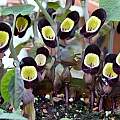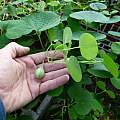Quick Characteristics:
| Flower Colors: | yellow, patterned |
Aristolochia steupii Woronow is an endemic species with a very small distribution range in the western Caucasus (mainly in Abkhazia but also on the Russian side of the border), and it grows in humid deciduous forests. The climate is influenced by the Black Sea, with year-round heavy rainfall and mild, mostly frost-free winters characterizing the area. The contrasting black and yellow flowers are very striking. It forms fist-sized tubers from which numerous shoots develop in the spring. It flowers for several weeks after emergence. In late summer, the shoots die back. The new growth is already developed underground in the autumn and emerges above the ground over the winter. Height: to about 30 cm.
The species is rarely cultivated so far. Plant outdoors only in regions with mild winters; protect shoots from frost. Otherwise, plant in pots, kept cool but frost-free in winter, and placed outdoors in the summer. The substrate should be rich and well-draining (e.g., a mix of leaf compost and mineral components in a 50-50 ratio). Keep it consistently moist throughout the year, and never let it dry out even during its dormant period. Plants tend to grow better in large pots. Optimal light conditions are in dappled shade. Propagation by seed requires patience: the seeds typically germinate in the 3rd and 4th winter after sowing. The seeds should never dry out, so it's best to keep the sowing container inside a bag and regularly check for moisture. Germination occurs in winter. The relatively large seedlings can be easily pricked out. Expect flowering after approximately 3 years. Pictures by Eckhard Gottschalk.

